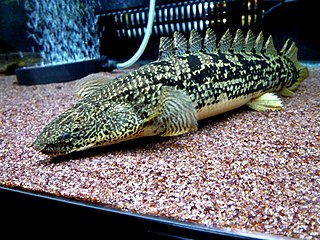
Bichirs and the reedfish comprise Polypteridae, a family of archaic ray-finned fishes and the only family in the order Polypteriformes.

Polypterus senegalus, commonly known as the Senegal bichir, gray bichir or Cuvier's bichir, is an African species of ray-finned fish in the bichir family, Polypteridae. It is a typical example of polypterid fishes, as most of its defining physical features are common across the genus, such as its ancient, lungfish- or arowana-like appearance, the ability to breathe atmospheric oxygen, and its armor-like scales. These factors have influenced the species' popularity in captivity, and it is commonly kept by aquarists and other hobbyists.
This glossary of ichthyology is a list of definitions of terms and concepts used in ichthyology, the study of fishes.

The blurred lanternshark is a little-known species of dogfish shark in the family Etmopteridae, found around the world in benthic and pelagic habitats from a depth of 110 m (360 ft) to over 1 km (0.62 mi) down. This shark forms the E. pusillus species group with the smooth lanternshark, which are distinguished from other members of its family by having irregularly arranged, flat-topped dermal denticles that give them a "smooth" appearance. Both species are slender-bodied with long heads, two dorsal fins bearing spines, no anal fins, and light-emitting photophores. The blurred lanternshark is larger, reaching 67 cm (26 in) or more in length. This species feeds on small squid, fishes, and fish eggs, and is ovoviviparous. It has been assessed as of Least Concern by the International Union for Conservation of Nature, because of its wide distribution and lack of threat from fishing pressure.

Tristichopterus, with a maximum length of sixty centimetres, is the smallest genus in the family of prehistoric lobe-finned fish, Tristichopteridae that was believed to have originated in the north and dispersed throughout the course of the Upper Devonian into Gondwana. Tristichopterus currently has only one named species, first described by Egerton in 1861. The Tristichopterus node is thought to have originated during the Givetian part of the Devonian. Tristichopterus was thought by Egerton to be unique for its time period as a fish with ossified vertebral centers, breaking the persistent notochord rule of most Devonian fish but this was later reinspected and shown to be only partial ossification by Dr. R. H. Traquair. Tristichopterus alatus closely resembles Eusthenopteron and this sparked some debate after its discovery as to whether it was a separate taxon.

Polypterus ornatipinnis, the ornate bichir, is a bony fish of the family Polypteridae found in Lake Tanganyika and the Congo River basin in Central and East Africa. It is known from the Central African Republic, the Democratic Republic of the Congo, and Tanzania.

The barred bichir, armoured bichir, bandback bichir, or banded bichir is a species of fish belonging to the class Actinopterygii, or the ray-finned fish, which constitute an order of the class of the bony fish. an elongated fish found in the Congo River, specifically in the upper and middle portions. This species is one of the more commonly available in commercial pet stores.
Sternarchogiton labiatus is a species of weakly electric knifefish in the family Apteronotidae. Its species name labiatus comes from the Latin labium, meaning "lip", referring to a distinctive three-lobed structure on its lower lips. S. labiatus is only known from the Tefé River, at a depth of 6–14 m (20–46 ft), and from the lower Rio Negro, in the Amazon River basin. They have been captured from both whitewater and blackwater habitats.
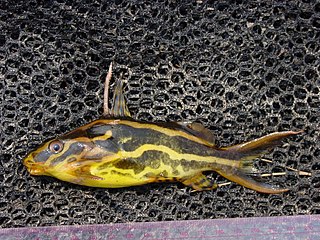
Synodontis flavitaeniatus, known as the orangestriped squeaker, the chocolatestriped squeaker, the yellowstriped squeaker, and the pyjama Syno, is a species of upside-down catfish native to the Democratic Republic of the Congo and the Republic of the Congo where it is found in the lower and central Congo Basin. It was first described by Belgian-British zoologist George Albert Boulenger in 1919. The holotype was collected from the Ruki River at Eala, in the Democratic Republic of the Congo. The meaning of the specific name "flavitaeniatus" is "yellow stripes".
The Cook's swellshark is a little-known species of catshark, belonging to the family Scyliorhinidae. This shark is found in the Arafura Sea at a depth of 223–300 m (732–984 ft). It is a stocky-bodied shark with a short, broad head and a large mouth, and can be identified by the eight dark, pale-edged saddles along its grayish brown body and tail. The maximum known length of this species is 30 cm (12 in). Like other swellsharks, it can inflate itself with water or air when threatened.
The flagtail swellshark is a little-known species of catshark, belonging to the family Scyliorhinidae, found at a depth of 480–700 m (1,570–2,300 ft) off northeastern Queensland, and possibly also nearby islands. This stout-bodied shark has a short, broad, and flattened head with a capacious mouth. Adults have a variegated brown coloration with 9–10 darker dorsal saddles and V-shaped blotch at the tip of the upper caudal fin lobe. Juveniles are yellow with narrow brown bars instead of saddles, and a distinctive marking between the spiracles shaped like two loops connected by a line. Like other swellsharks, this species can inflate its body when threatened.

Schismatogobius insignus is a species of goby endemic to the Philippines. It is a small fish, growing to a maximum length of only 4.4 cm (1.7 in). It is found in coastal marine, brackish, and freshwater habitats.

Oplopomus oplopomus, commonly known as the spinecheek goby, is a species of goby native to the Indo-Pacific region. They can grow to a maximum length of 10 centimetres (3.9 in). They inhabit coral reefs.
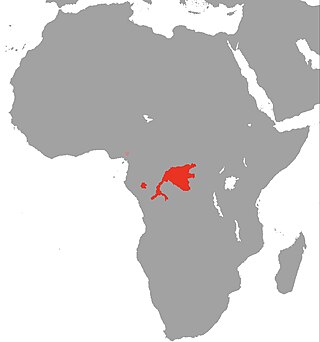
The West African bichir or retropinnis bichir, is a freshwater fish in the family Polypteridae, is found in the central Congo River basin and Ogooué River in Africa. It is a long, slender fish that grows to a maximum length of about 34 cm (13 in).

Polypterus teugelsi is a species of carnivorous, nocturnal bichir that lives in the Cross River drainage basin in the country of Cameroon. P. teugelsi was described in 2004 by Ralf Britz.
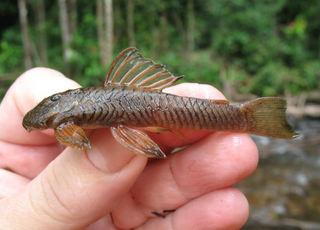
Guyanancistrus nassauensis is a species of catfish belonging to the family Loricariidae, the suckermouth armored catfishes. It is discovered in 2005 and formally described in 2018. G. nassauensis is a rare species, highly endemic to the Nassau Mountains in Suriname, and is threatened with extinction by proposed or ongoing mining activities.

Polypterus mokelembembe is a species of the fish genus Polypterus, found in the central basin of the Congo River. It was once considered a morph of the closely related Polypterus retropinnis, but was given species status in 2006 with a description that reclassified both fishes. Because of the recency of the species' description and the fact that P. mokelembembe is the paralectotype of P. retropinnis, they are often mistaken for one another in the aquarium trade.
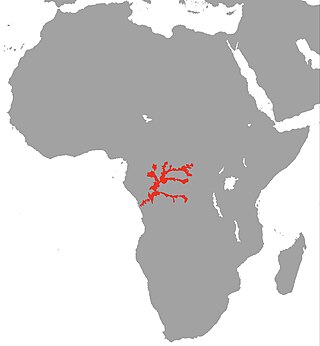
Polypterus polli, Poll's bichir, is a species of bichir from the Malebo Pool and the lower and central basins of the Congo River. It was named in honor of Belgian ichthyologist Max Poll.
Placidochromis boops is a species of deep-water African cichlid endemic to the southern portion of Lake Malawi. This species can reach a length of up to 11.2 centimetres (4.4 in) SL.
Archolaemus luciae is a species of glass knifefish endemic to Brazil where it is found in the Rio Jari, the Rio Trombetas and the Rio Tapajós basins in the eastern Amazon. Also found in the Rio Araguari. This species reaches a length of 49.7 cm (19.6 in).














